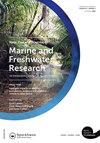Suspended sediment and faecal contamination in a stormflow plume from the Hutt River in Wellington Harbour, New Zealand
IF 1.4
4区 环境科学与生态学
Q3 FISHERIES
New Zealand Journal of Marine and Freshwater Research
Pub Date : 2022-07-03
DOI:10.1080/00288330.2022.2088569
引用次数: 1
Abstract
ABSTRACT Muddy, faecally-contaminated river flood plumes in coastal waters are a hazard to contact recreation and bivalve shellfish consumption but are difficult to study, being episodic and transient. We used a new underway flow-through sampler in a small, fast boat, to map a flood plume within Wellington Harbour, while simultaneously sampling water in the Hutt River inflow. Faecal contamination (indexed by E.coli) correlated with flow, salinity, coloured dissolved organic matter, total suspended solids (TSS) and water clarity (light beam attenuation and visual clarity). The freshwater content of the plume agreed well with time-integrated river discharge. Despite the relatively short time-scale (<12 h) of the event, a 21% loss of TSS (particle flocculation and settling), and 30% loss in E. coli (suggesting some die-off) occurred in the plume compared to river loads. E. coli relative to TSS varied up to two orders of magnitude over a year of river flood sampling. A rapid survey of plumes combined with long-term river observations is expected to augment monitoring and inform the extension of remote sensing and modelling efforts to faecal contamination of New Zealand coastal waters.新西兰惠灵顿港赫特河的暴雨流中悬浮的沉积物和粪便污染
在沿海水域,浑浊的、粪便污染的河流洪水羽流对接触娱乐和双壳类贝类消费构成危害,但难以研究,是偶然和短暂的。我们在一艘小船上使用了一种新的流水采样器,绘制了惠灵顿港内的洪水羽流图,同时对赫特河流入的水进行了采样。粪便污染(以大肠杆菌为指标)与流量、盐度、有色溶解有机物、总悬浮固体(TSS)和水的清晰度(光束衰减和视觉清晰度)相关。羽流的淡水含量与河流流量的时间积分一致。尽管事件的时间尺度相对较短(<12小时),但与河流负荷相比,羽流中发生了21%的TSS损失(颗粒絮凝和沉淀)和30%的大肠杆菌损失(表明一些死亡)。在一年的河流洪水采样中,大肠杆菌相对于TSS的变化高达两个数量级。对羽流的快速调查与长期河流观测相结合,预计将加强监测,并为扩大新西兰沿海水域粪便污染的遥感和建模工作提供信息。
本文章由计算机程序翻译,如有差异,请以英文原文为准。
求助全文
约1分钟内获得全文
求助全文
来源期刊
CiteScore
4.50
自引率
12.50%
发文量
35
审稿时长
3 months
期刊介绍:
Aims: The diversity of aquatic environments in the southern continents and oceans is of worldwide interest to researchers and resource managers in research institutions, museums, and other centres. The New Zealand Journal of Marine and Freshwater Research plays an important role in disseminating information on observational, experimental, theoretical and numerical research on the marine, estuarine and freshwater environments of the region.

 求助内容:
求助内容: 应助结果提醒方式:
应助结果提醒方式:


